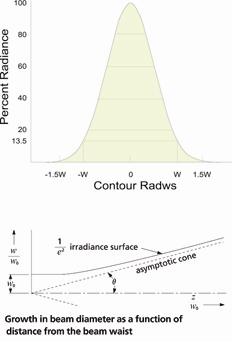 Laser Glossary
Laser Glossary Beam Diameter
Beam Diameter
The distance between diametrically opposed points in the cross section of a circular beam where the intensity is reduced by a factor of 1/e (0.368) of the peak level (for safety standards). The value is normally chosen at 1/e2 (0.135) of the peak level for manufacturing specifications.
Beam Divergence
Angle of beam spread measured in radians or milliradians. For small angles where the cord is approximately equal to the arc, the beam divergence can be closely approximated by the ratio of the cord length (beam diameter) divided by the distance (range) from the laser aperture.
Continuous Wave (CW)
Constant, steady-state delivery of laser power.
ESD
Both people and devices frequently develop electrical charge through the action of static electricity. When contact with another item is made, the built up charge is often "discharged" into this item. This discharge is known as electrostatic discharge (ESD). While ESD voltages frequently exceed 3,000 volts, the current associated with ESD is low making it safe, though at times unpleasant, for humans.
Helium Neon (HeNe) Laser
One of the most common types of lasers, the HeNe laser uses a combination of helium and neon gas as its laser medium. Although the most common output wavelength is 632.8nm, HeNe lasers are available in several different wavelengths.
Linear Polarizer
A type of polarizer used to limit the oscillations of electromagnetic waves to a specific plane by absorbing components oscillating in planes other than the specified polarization transmission axis.
Line Width
For focusable lasers, the laser can be focused prior to addition of the line generator. The width of the line created by a line generator is equivalent to the beam spot diameter at the target without the line generating optic. The length of the line is defined by the fan angle.
Modulation Input
The input to a modulatable device that leads to the variations in the output. The relationship between modulation input and output is often linear to preserve relationships between signal fluctuations.
Nd:YAG Laser
A solid-state laser that uses a neodymium-doped yttrium aluminum garnet (YAG) crystal as the lasing medium. The principal output of this laser is at 1064nm.
M2 Factor
M2 (called the “M-square” factor), has been defined to describe the deviation of the laser beam from a theoretical Gaussian. For a theoretical Gaussian, M2=1; for a real laser beam, M2>1.
Output Power
The power measured at the exit of a laser cavity, commonly expressed as minimum output or maximum output. The class designation of a laser is based in part upon this characteristic.
Transistor-Transistor Logic (TTL)
Refers to a common digital logic family of devices used for control in most modern electronics. TTL signals have two distinct states; "low" and "high." A logic "low" corresponds to a maximum voltage threshold of 0.8 volts; a "high" corresponds to a voltage greater than 2.5 volts (typically used voltage levels are 5-12V DC).
Visible Spectrum
The wavelength interval of the electromagnetic spectrum which corresponds to visible light (light that is sensitive to the human eye). The range commonly used is 400 to 750nm, though sensitive eyes can often see out to 780nm (in the Near-IR by definition).
Wavelength
Electromagnetic radiation propagates as a sinusoidal wave. The wavelength of the wave is the length of one complete cycle. The velocity (v) of the wave is determined by the equation frequency of a wave are related by the equation
v = ν × λ
where ν is the frequency of the wave and λ is the wavelength.